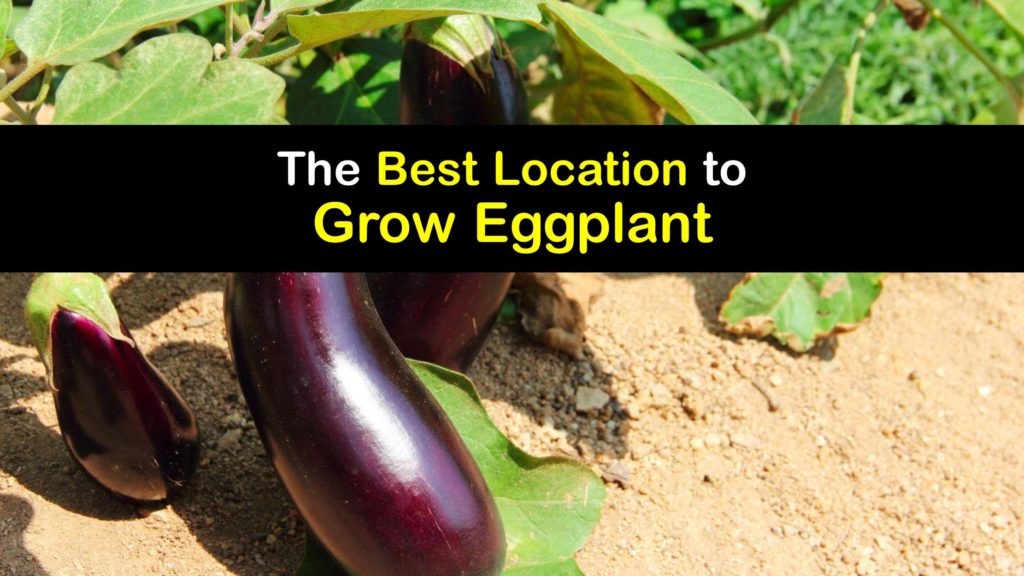If you’ve grown tomato plants before, you might have an advantage in growing eggplants because both are nightshade plants with similar growing requirements. Eggplants are a warm-season crop and thrive in the southern United States, where the temperatures are warm and the sun is bright. Despite this, it is possible to have successful eggplant yields in other parts of the country once you understand where to plant eggplant.
Eggplants aren’t known for their nutritional value, lacking in both macro and micronutrients. The spongy texture of eggplant makes this vegetable interesting and allows it to absorb the oils and flavors of whatever it’s cooked with.
There are various types of eggplant to grow, each with its benefit to gardeners, and deciding which type of eggplant to grow at home may come down to flavor and size. Like most plants, caring for and growing eggplants requires tending to their specific needs regarding soil quality and nutrients and ensuring your plants get enough daily sunlight to grow delicious eggplants.

Planting Eggplants (Solanum melongena)
Eggplants are warm-season vegetables, and they enjoy growing in shorter warm seasons. If you plan on growing eggplants in a cooler growing zone, maintain the temperature of your soil and the amount of sun available to your plants when selecting a location for growing eggplants.
Eggplant Sun Requirements
To start growing eggplants, it’s essential to select how you want to introduce eggplants to your garden. Start growing eggplant from seed or eggplant seedlings purchased from a nursery when growing an eggplant. Seedlings are the most expensive, but if you have a shorter growing season, it may be the best option to ensure your eggplant grows in the hot weather it loves.
If your eggplant grows in the shadow of taller plants, it stunts your plant’s growth. When plants don’t receive adequate sunlight, they fail to produce chlorophyll, a pigment that gives plants their signature green color, ensuring they are healthy.
Without chlorophyll, your eggplant’s foliage turns from green to yellow to white. The stems become long and thin as your plant struggles to grow without enough sun. These eggplant plant stages are known as “becoming leggy” as they stretch upward to find more sunlight.

How much sun do eggplants need to grow? Continue reading for more information on eggplant sun requirements and what you need to have your eggplant fruit reach harvest.
How Much Sun do Eggplants Need to Grow?
Does eggplant need full sun? Yes, eggplants require full sun to grow and produce fruit in warm soil. Although you can grow eggplants without your plant growing in full sun, the result won’t be as impressive as a plant that receives full sun daily.
Plants that don’t receive at least six hours of direct sunlight a day may not grow as tall as other plants, and the fruit may be undersized. If you practice crop rotation, consider designating a spot in the garden for your eggplants so you don’t risk placing them in the shadow of another plant.
To start seeds indoors before the weather warms, leave your plant’s pot on a heating pad to get your eggplant off to the right start. As your plant grows, transplant it into the garden or leave it inside to grow under an indoor UV grow light.
These lights are available online or in garden centers, and they mimic the sun’s rays so that your indoor plants receive adequate sunlight while growing inside your house.
Where to Plant Eggplant
If you’re starting eggplants in the garden, sow eggplant seeds directly into the garden once the threat of frost passes. For the best chance of germination, plant eggplant seeds when the soil temperature is at least 50°F; however, the warmer, the better. Use a soil thermometer to monitor the soil temperatures and if the soil is not warm enough, use black plastic or plastic mulch to help warm the soil.
If the soil temperature isn’t a concern for your garden, spread organic matter mulch around your seed locations to help retain soil moisture. Keep the soil moist and wait roughly a week for your seed to sprout.
To start indoors, plant your eggplant seed in a biodegradable container four to eight weeks before the last frost date in your area. Eggplant seeds don’t require sunlight to germinate, only warm soil. When your seedlings reach at least four inches tall, and there is no threat of frost, begin hardening off your plants outdoors.
Leave your potted plant outdoors for an hour a day, adding one hour each day until your plant remains outside for six or seven hours. The importance of hardening off your plants is to acclimate them to the outdoor growing conditions before transplanting them.
Choosing an Eggplant Variety
When selecting an eggplant to grow, there is more to know than just eggplant sun requirements. Eggplants have various cultivars of purple and white fruits that vary in size, texture, and disease resistance. The latter is essential to picking which of the different types of eggplants to grow because a variety that resists disease creates less work for gardeners.
Black King is a hybrid eggplant from Japan that is a high yielder. This variety produces oval-shaped fruits and boasts resistance to verticillium wilt. The Fairy Tale eggplant is a mini eggplant that grows light purple fruits on white stems. Because of their small size, these eggplants are an ideal vegetable for container gardening.
Diamond eggplants probably match the idea of what a perfect eggplant looks like. This variety grows long, deep purple fruits on bright green stems. The fruits grow to around nine inches and are disorder-resistant.
Rolandia eggplants are resistant to tobacco mosaic virus, and this plant grows dark purple fruit around eight inches. These fruits are well-known for their extended shelf life after harvest. Rosa Bianca is an heirloom eggplant resistant to disorders like blossom end rot. These fruits are a light purple-pink that reaches maturity in about 80 days.
Caring for and Harvesting Eggplants
Aside from providing your eggplants with enough sun to thrive and keeping the soil moist, growing eggplants has a few other requirements.
Add organic mulch around your plants to prevent weeds from growing and competing with your eggplants for the nutrients in your garden. Eggplants are heavy feeders that won’t do well in the presence of weeds that absorb the same nutrients. Use a natural fertilizer for eggplant like banana peels, eggshells, and coffee grounds.
Worrying about how much sun do eggplants need to grow isn’t the only concern for growing eggplants. Garden pests usually feed on your plant before you get to harvest eggplants.
Tomato hornworms, flea beetles, and the Colorado potato beetle are the most common pests that target eggplants. The most efficient way to avoid these pests is to protect your eggplants with row covers. The covers allow sunlight to reach your plants but prevent garden pests from getting through.
Another form of pest control for your garden is companion planting. Plants with strong smells like basil are perfect eggplant companion plants to repel pests. Companion plants like marigolds and nasturtium also repel harmful insects while their flowers attract beneficial insects like bees and natural predators for pests.
When it’s time to harvest fruit from your plants, look for eggplants with glossy skin. Use shears or a sharp knife to slice the eggplant stem when harvesting eggplants. Eggplant can last in the refrigerator for a week before using it in Eggplant Parmesan or another delicious dish.
Cut the eggplant into circles and pat them dry with paper towels. Sprinkle your eggplant circles with your seasonings, warm your olive oil in a skillet and add your eggplants to cook them evenly on both sides.
Although eggplants thrive in warm soil, it doesn’t mean you’re restricted to growing them outdoors in the summer heat. Utilize a heating pad and natural sunlight from a windowsill to grow a garden of eggplants no matter where you live.

If this article helped you figure out where to plant eggplant, please share our tips with your friends on Facebook and Pinterest to answer their questions about “How much sun do eggplants need to grow?”